Easy Algebra Step-by-Step: Master High-Frequency Concepts and Skills for Algebra Proficiency—FAST! (2012)
Chapter 6. Algebraic Expressions
This chapter presents a discussion of algebraic expressions. It begins with the basic terminology that is critical to your understanding of the concept of an algebraic expression.
Algebraic Terminology
A variable holds a place open for a number (or numbers, in some cases) whose value may vary. You usually express a variable as an upper or lower-case letter (e.g., x, y, z, A, B, or C); for simplicity, the letter is the “name” of the variable. In problem situations, you use variables to represent unknown quantities. Although a variable may represent any number, in many problems the variables represent specific numbers, but the values are unknown.
A constant is a quantity that has a fixed, definite value that does not change in a problem situation. For example, all the real numbers are constants, including πe real numbers whose units are units of measure such as 5 feet, 60 degrees, 100 pounds, and so forth.
You can think of variables as numbers in disguise. Not recognizing that variables represent numbers is a common mistake for beginning students of algebra.
Problem Name the variable(s) and constant(s) in the given expression.
a. ![]() , where F is the number of degrees Fahrenheit
, where F is the number of degrees Fahrenheit
b. πd, where d is the measure of the diameter of a circle
Solution
a. ![]() , where F is the number of degrees Fahrenheit
, where F is the number of degrees Fahrenheit
![]() Step 1. Recall that a letter names a variable whose value may vary.
Step 1. Recall that a letter names a variable whose value may vary.
Step 2. Name the variable(s).
The letter F stands for the number of degrees Fahrenheit and can be any real number, and so it is a variable.
Step 3. Recall that a constant has a fixed, definite value.
Step 4. Name the constant(s).
The numbers ![]() and 32 have fixed, definite values that do not change, and so they are constants.
and 32 have fixed, definite values that do not change, and so they are constants.
b. πd, where d is the measure of the diameter of a circle
![]() Step 1. Recall that a letter names a variable whose value may vary.
Step 1. Recall that a letter names a variable whose value may vary.
Step 2. Name the variable(s).
The letter d stands for the measure of the diameter of a circle and can be any nonnegative number, and so it is a variable.
Step 3. Recall that a constant has a fixed, definite value.
Step 4. Name the constant(s).
The number π has a fixed, definite value that does not change, and so it is a constant.
Even though the number pi is represented by a Greek letter, π is not a variable. The number π is an irrational number whose approximate value to two decimal places is 3.14.
If there is a number immediately next to a variable (normally preceding it), that number is the numerical coefficient of the variable. If there is no number written immediately next to a variable, it is understood that the numerical coefficient is 1.
Problem What is the numerical coefficient of the variable?
a. –5x
b. y
c. πd
Solution
a. –5x
![]() Step 1. Identify the numerical coefficient by observing that the number –5 immediately precedes the variable x.
Step 1. Identify the numerical coefficient by observing that the number –5 immediately precedes the variable x.
–5 is the numerical coefficient of x.
b. y
![]() Step 1. Identify the numerical coefficient by observing that no number is written immediately next to the variable y.
Step 1. Identify the numerical coefficient by observing that no number is written immediately next to the variable y.
1 is the numerical coefficient of y.
c. πd
![]() Step 1. Identify the numerical coefficient by observing that the number π immediately precedes the variable d.
Step 1. Identify the numerical coefficient by observing that the number π immediately precedes the variable d.
π is the numerical coefficient of d.
Evaluating Algebraic Expressions
Writing variables and coefficients or two or more variables (with or without constants) side by side with no multiplication symbol in between is a way to show multiplication. Thus, –5x means –5 times x, and 2xyz means 2 times xtimes y times z. Also, a number or variable written immediately next to a grouping symbol indicates multiplication. For instance, 6(x + 1) means 6 times the quantity (x + 1), ![]() means 7 times
means 7 times ![]() , and –1|–8| means –1 times |–8|.
, and –1|–8| means –1 times |–8|.
An algebraic expression is a symbolic representation of a number. It can contain constants, variables, and computation symbols. Here are examples of algebraic expressions.

Ordinarily, you don’t know what number an algebraic expression represents because algebraic expressions always contain variables. However, if you are given numerical values for the variables, you can evaluate the algebraic expression by substituting the given numerical value for each variable and then simplifying by performing the indicated operations, being sure to follow the order of operations as you proceed.
Problem Find the value of the algebraic expression when x = 4, y = –8, and z = –5.
a. –5x
b. 2xyz
c. ![]()
d. ![]()
e. x2 – x – 12
Solution
a. –5x
![]() Step 1. Substitute 4 for x in the expression –5x.
Step 1. Substitute 4 for x in the expression –5x.
–5x = –5(4)
Step 2. Perform the indicated multiplication.
= –20
Step 3. State the main result.
–5x = –20 when x = 4.
b. 2xyz
![]() Step 1. Substitute 4 for x, –8 for y, and –5 for z in the expression 2xyz.
Step 1. Substitute 4 for x, –8 for y, and –5 for z in the expression 2xyz.
2xyz = 2(4)(–8)(–5)
When you substitute negative values into an algebraic expression, enclose them in parentheses to avoid careless errors.
Step 2. Perform the indicated multiplication.
= 320
Step 3. State the main result.
2xyz = 320 when x = 4, y = –8, and z = –5.
c. ![]()
![]() Step 1. Substitute 4 for x in the expression
Step 1. Substitute 4 for x in the expression ![]() .
.
![]()
![]() . The square root applies only to the 4.
. The square root applies only to the 4.
Step 2. Simplify the resulting expression.
=![]()
=![]()
=![]()
= 2
Step 3. State the main result.
![]() = 2 when x = 4.
= 2 when x = 4.
d. ![]()
![]() Step 1. Substitute 4 for x, –8 for y, and –5 for z in the expression
Step 1. Substitute 4 for x, –8 for y, and –5 for z in the expression
![]()

Step 2. Simplify the resulting expression.
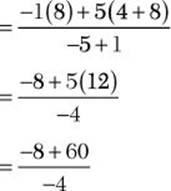
= ![]()
= –13
Step 3. State the main result.
![]() = –13 when x = 4, y = –8, and z = –5.
= –13 when x = 4, y = –8, and z = –5.
e. ![]()
![]() Step 1. Substitute 4 for x in the expression
Step 1. Substitute 4 for x in the expression ![]() .
.
![]()
Step 2. Simplify the resulting expression.
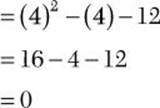
Step 3. State the main result.
![]() when x = 4.
when x = 4.
Problem Evaluate ![]() when x = –1.
when x = –1.
Solution
![]() Step 1. Substitute x = –1 for x in the expression
Step 1. Substitute x = –1 for x in the expression ![]() .
.

Step 2. Simplify the resulting expression.
![]()
Watch your signs! It’s easy to make careless errors when you are evaluating negative numbers raised to powers.
Step 3. State the main result.
![]() when x = –1.
when x = –1.
You can use your skills in evaluating algebraic expressions to evaluate formulas for given numerical values.
Problem Find C when F = 212 using the formula ![]() .
.
Solution
![]() Step 1. Substitute 212 for F in the formula
Step 1. Substitute 212 for F in the formula ![]() .
.
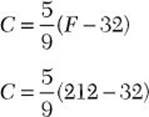
Step 2. Simplify.
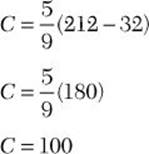
Step 3. State the main result.
C = 100 when F = 212.
Dealing with Parentheses
Frequently, algebraic expressions are enclosed in parentheses. It is important that you deal with parentheses correctly.
![]() If no symbol or if a (+) symbol immediately precedes parentheses that enclose an algebraic expression, remove the parentheses and rewrite the algebraic expression without changing any signs.
If no symbol or if a (+) symbol immediately precedes parentheses that enclose an algebraic expression, remove the parentheses and rewrite the algebraic expression without changing any signs.
Problem Simplify ![]()
Solution
![]() Step 1. Remove the parentheses without changing any signs.
Step 1. Remove the parentheses without changing any signs.
![]()
![]() If an opposite (–) symbol immediately precedes parentheses that enclose an algebraic expression, remove the parentheses and the opposite symbol and rewrite the algebraic expression, but with all the signs changed.
If an opposite (–) symbol immediately precedes parentheses that enclose an algebraic expression, remove the parentheses and the opposite symbol and rewrite the algebraic expression, but with all the signs changed.
Problem Simplify ![]()
Solution
![]() . Change all the signs, not just the first one. This mistake is very common.
. Change all the signs, not just the first one. This mistake is very common.
![]() Step 1. Remove the parentheses and the opposite symbol and rewrite the expression, but change all the signs.
Step 1. Remove the parentheses and the opposite symbol and rewrite the expression, but change all the signs.
![]()
![]() If a minus (–) symbol immediately precedes parentheses that enclose an algebraic expression, mentally think of the minus symbol as “+–,” meaning “add the opposite.” Then remove the parentheses and rewrite the algebraic expression, but change all the signs.
If a minus (–) symbol immediately precedes parentheses that enclose an algebraic expression, mentally think of the minus symbol as “+–,” meaning “add the opposite.” Then remove the parentheses and rewrite the algebraic expression, but change all the signs.
Problem Simplify ![]()
Solution
![]() Step 1. Mentally think of the minus symbol as “+–.”
Step 1. Mentally think of the minus symbol as “+–.”

Step 2. Remove the parentheses and rewrite the algebraic expression, but with all the signs changed.
![]()
![]() If a number immediately precedes parentheses that enclose an algebraic expression, apply the distributive property to remove the parentheses.
If a number immediately precedes parentheses that enclose an algebraic expression, apply the distributive property to remove the parentheses.
Problem Simplify 2(x + 5).
Solution
![]() Step 1. Apply the distributive property.
Step 1. Apply the distributive property.
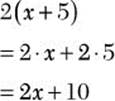
![]() . You must multiply the 5 by 2 as well.
. You must multiply the 5 by 2 as well.
 Exercise 6
Exercise 6
1. Name the variable(s) and constant(s) in the expression 2πr, where r is the measure of the radius of a circle.
For 2–4, state the numerical coefficient of the variable.
2. –12y
3. z
4. ![]()
For 5–12, find the value of the algebraic expression when x = 9, y = –2, and z = –3.
5. –5x
6. 2xyz
7. ![]()
8. ![]()
![]()
![]()
11. ![]()
![]()
For 13–15, find the variable using the formula given.
13. Find A when b = 12 and h = 8 using the formula ![]()
14. Find V when r = 5 and h = 18 using the formula ![]() Use π = 3.14.
Use π = 3.14.
15. Find c when a = 8 and b = 15 using the formula ![]()
For 16–20, simplify by removing parentheses.
16. ![]()
![]()
![]()
![]()
![]()